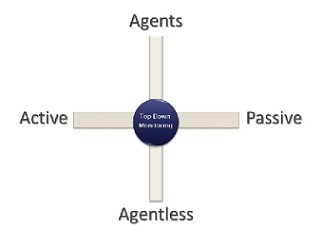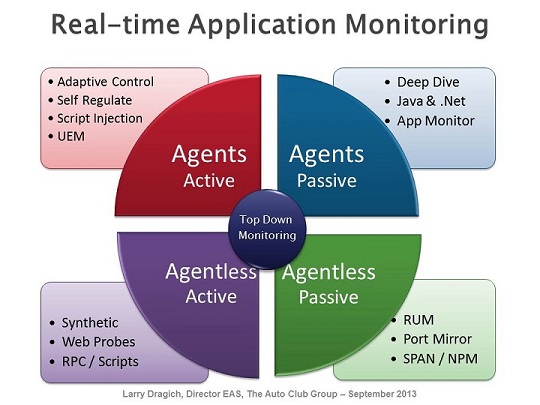Predicting the performance perils from application deployments requires more than just a toolset, but a mindset that is open to multiple inputs and continuous improvement. Acquiring an appreciation for an application monitoring taxonomy will be useful when gathering end user requirements for an APM implementation.
Understanding the nuances between active and passive monitoring within this paradigm will help facilitate a more focused approach for technology selection.
Before you pull the trigger on a new monitoring tool think about “what” you will deploy (i.e. agents or agentless) and “how” it will be configured to monitor the transactions (i.e. actively or passively).

Depending on your requirements, acquiring a specific technology that only lands in one of these quadrants may be all you need to get the job done. As you plot your answers on the graph above you may find that some of these technologies will span multiple quadrants based on their vendor offerings.
Agent Technology can actively modify the application stream to collect measurements for end-user-experience (EUE) observations (e.g. script injection), or passively watch the traffic providing deep dive analysis of the application stack.
Agentless Technology has two categories that are mutually exclusive. The first actively creates synthetic transactions to measure application performance and availability. The second passively monitors application traffic through network port mirroring and has roots in the Network Performance Monitoring (NPM) space, which is now evolving into application-aware NPM (AANPM).

No matter what the configuration comes out to be, you’re striving for a robust real-time application monitoring solution which will most likely utilize a combination of active and passive monitoring techniques. This is where you see a multitude of vendor offerings promising the best way to accomplish the goal of APM.
Conclusion
Top-down monitoring is probably what people think about the most when talking about Application Performance Monitoring. Once you begin to focus on Application Performance Management however, three other elements will come into play for your consideration: Bottom-up monitoring, Reporting & Analytics, ITSM/ITIL Processes. Which one will you focus on next?
You can contact Larry on LinkedIn.
Related Links:
For more information on the basic Principles of APM and how it can be applied to any monitoring initiative or strategic discussion about application performance refer to the webcast on BrightTALK.com: Solving the Performance Puzzle: A Simple APM Methodology
The Butterfly Effect Within IT
APM: Running With a Renegade - DevOps






